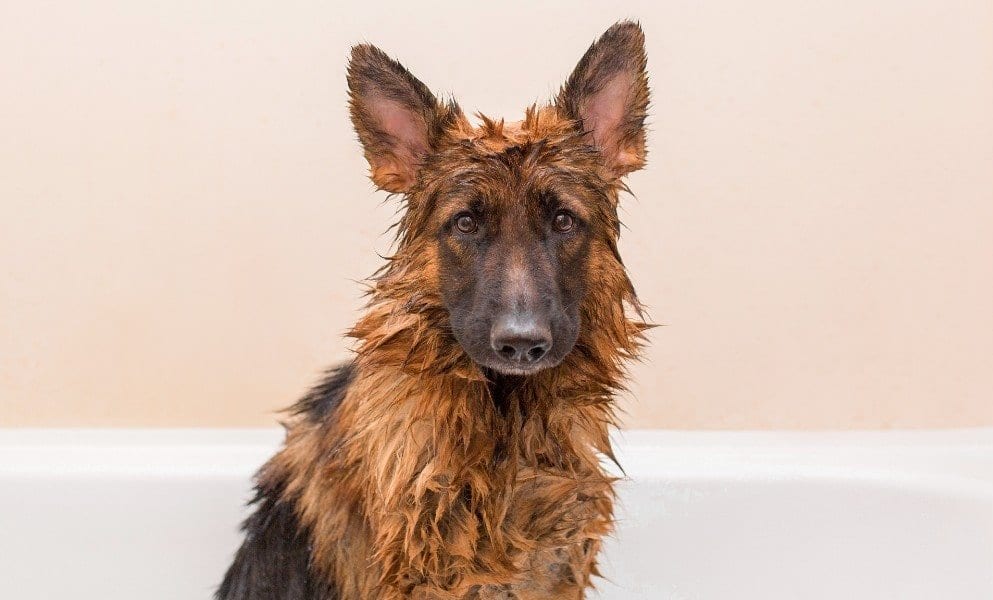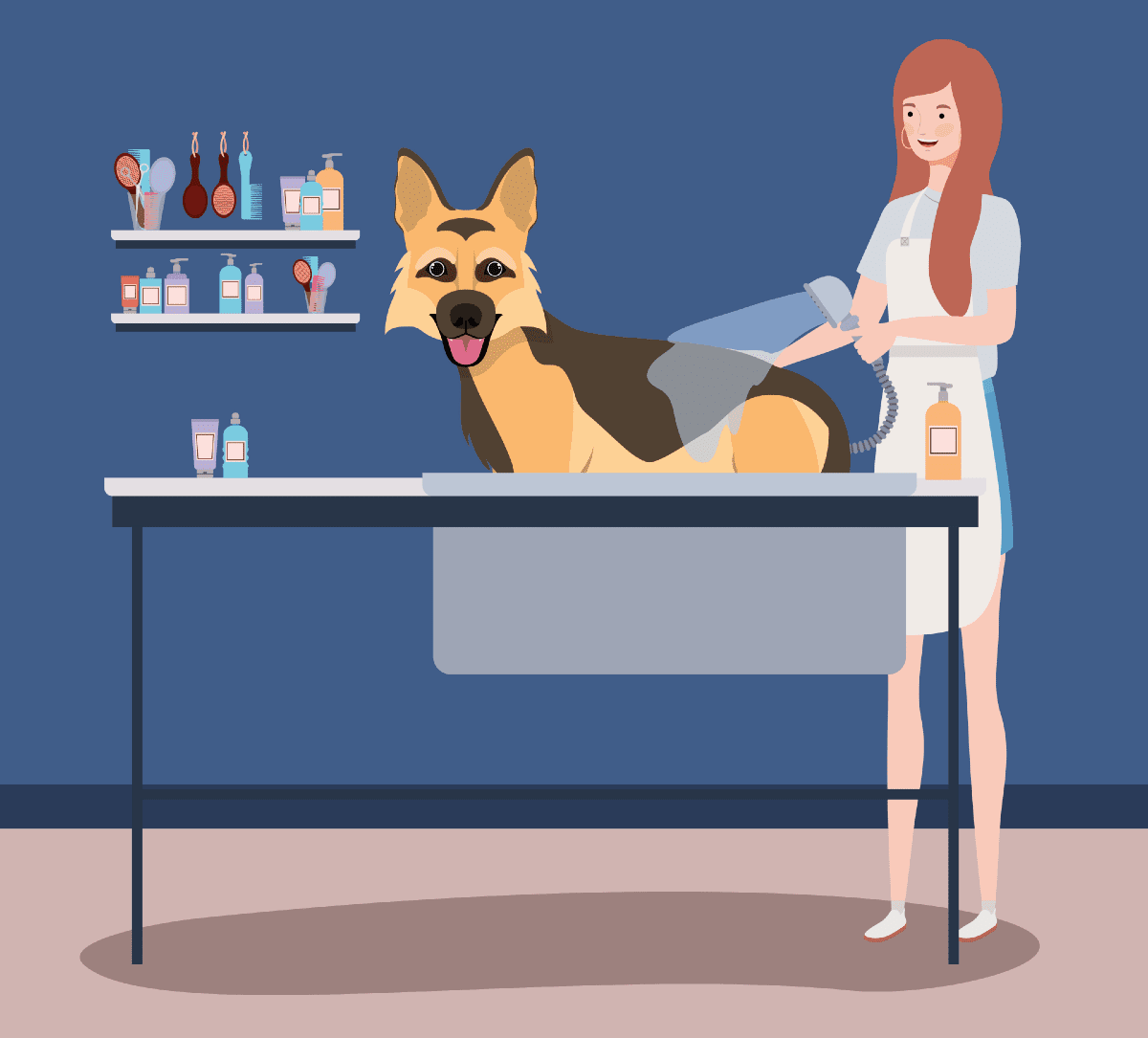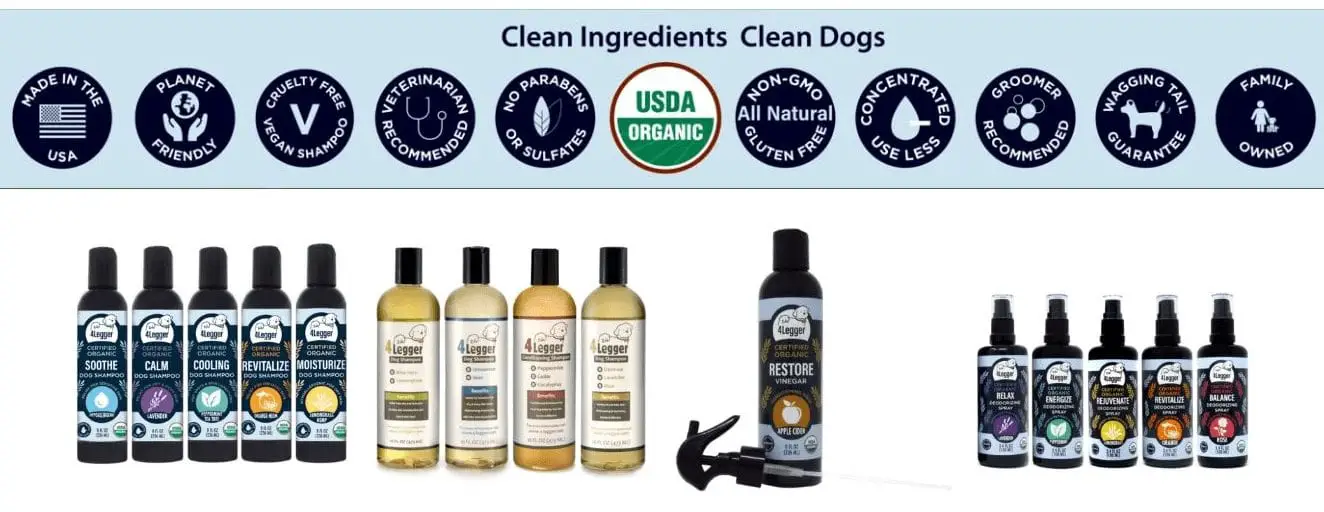According to the American Pet Products Association, $70 billion is what Americans spent on their pets in 2017. Pet parents spent about 10%, or roughly $7 billion, on grooming, boarding, and services.
Not all pet products are created equally. Items marketed as safe for dogs or pet-friendly don’t mean it doesn’t contain harmful chemicals, dyes, toxins, or synthetics.
Harsh Chemicals in Cleaning Products
Chemicals are everywhere in our daily lives, including everyone’s soaps and shampoos.
Dogs are more sensitive to harsh chemicals than humans because their skin’s pH is different. Human skin PH is around 4 to 5.5, dog’s and cat’s skin pH is about 7.0 to 7.2.
All mammals have a protective layer of acidic oil, or acid mantle, that covers the top layer of skin. Soaps and shampoos for humans are created with human acid mantle and pH in mind.
That’s why it’s important to use shampoo and grooming products made specifically for dogs. If your dog’s coat and skin become dry, flaky, or irritated after a bath, the ingredients in the dog shampoo may be the cause.
5 Ingredients to Avoid in Dog Shampoo
Dogs like to groom themselves by licking. Some dogs lick a lot. Residue from soaps, sprays, and medications eventually end up in their digestive system and internal organs. Harmful chemicals can lead to severe health conditions like cancer.
Here are five ingredients to avoid in Dog Shampoo.
1. Special Formula or Signature Blend – products that list a proprietary formula or blend instead of actual ingredients should be a red flag and avoided.
2. Artificial Fragrances – anything artificial is unhealthy for humans and pets. Artificial fragrance chemicals typically aren’t directly listed on labels. Look for Styrene and Phthalates, which are ingredients commonly used in commercial fragrances.
Styrene was ruled as “reasonably anticipated to be a human carcinogen” by the National Toxicology Program in 2011.
Phthalates are hormone disruptors that can cause reproductive cancers in humans and pets.
3. Preservatives – the term preservative in dog shampoo usually means any of the following four:
- Formaldehyde releasers
- Isothaizolinones
- Sodium Benzoate
- Parabens
Formaldehyde releasers are preservatives that release formaldehyde at low levels and can cause health concerns. Formaldehyde is a known carcinogen that can be absorbed through the skin and can cause skin reactions and rashes.
Formaldehyde won’t be on a product’s label. Look for the following Formaldehyde releasers:
- 2-bromo-2-nitropropane-1,3-diol (bromopol)
- Diazolidinyl urea
- DMDM Hydantoin
- Imidazolidinyl urea
- Quaternium-7, -15, -31, -61
Isothaizolinones preservatives can create allergies that cause itchy red skin, organ system toxicity, and neurotoxicity, breaking down into nitrosamines. Nitrosamines are linked to cancer.
Isothaizolinones preservatives will be labeled as:
- Methylisothiazolinone
- Methylchloroisothiazolinone
Sodium Benzoate by itself is not harmful. When sodium benzoate and citric acid or ascorbic acid (vitamin C) are mixed, they become benzene which is a cancer-causing chemical associated with leukemia and other blood disorders
Parabens are believed to be stored in the body and have a cumulative effect creating health risks such as estrogen disruption, breast cancer, and reproductive issues.
The most common Parabens hide as the following ingredients:
- Butylparaben
- Methylparaben
- Propylparaben
- Sodium Salt
If a dog grooming product simply lists preservatives as an ingredient, look for another product. A manufacturer not listing what specific preservative is in their product is a red flag.
4. Mineral Oil – First and foremost, Mineral Oil is not a natural substance. It’s a chemical byproduct of petroleum used in gasoline production.
Mineral Oil is marketed as a skincare product for humans to help reduce dry skin, among many other things. However, applying mineral oil to the skin seals off pores and inhibits the skin from breathing.
Using a dog shampoo or grooming product with Mineral Oil will block your dog’s naturally produced oils and encourage bacteria and yeast growth.
5. Sulfate – Specifically look for these three varieties:
- Sodium Lauryl Sulfate
- Sodium Laureth Sulfate
- Ammonium Laureth Sulfate
These three Sulfates are found in hundreds of human and pet products. These chemicals do not process in the liver quickly but linger in internal organs for up to a week. The length of time to process these chemicals increases the chance of damage to the brain, heart, and liver.
This list is just a few of the chemicals found in dog shampoo and grooming products.
You might assume your veterinarian could knowledgeably recommend safe products for pets. However, food and grooming products are glossed over in vet school.
Also, keep in mind that your vet may recommend shampoos and grooming products that their clinic carries.
Unless a veterinarian has an eastern medicine or holistic approach to their practice, their recommendations may be well-intended but uninformed.
No one is going to take better care of your dog than you. It’s up to you to do a little research and read labels when it comes to everything you feed, give, and use on your dog.
Toxic-Free Dog Shampoo
Bathtime should result in a clean dog with no harmful effects. Don’t buy products just because it says safe, all-natural, organic, veterinarian recommended, no sulfates, gluten-free, etc. Don’t be a victim of clever marketing, which we are all guilty of from time to time.
Instead, you want a dog shampoo that says all of the above plus USDA Organic. Typing in USDA Organic Dog Shampoo in the search browser is going to cut down the options quickly.
USDA Organic Dog Shampoo Recommendation
4-Legger USDA Certified Organic Grooming Products
4-Legger’s USDA Certified Organic pet shampoo has all-natural and organic ingredients you can trust and pronounce.
Use quality dog shampoo with safe ingredients because your dog is worth it.
Check out 4-Legger and shop their products at 4-legger.com or buy on Amazon.
Commission Disclosure – Articles on German Shepherd Country are for education or entertainment purposes. We may earn a small commission (at no extra cost to you) if you shop through links on this page. If you choose not to use them, we hope you find the information helpful!























